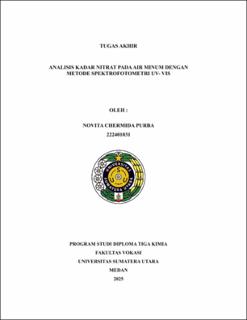| dc.description.abstract | Access to safe and potable drinking water is a fundamental human right essential for public health. Drinking water must adhere to quality standards that include physical, chemical, and microbiological parameters. One critical chemical parameter is nitrate (NO3-), an inorganic compound that naturally occurs in the environment, largely due to organic matter decomposition, agricultural fertilizers, and waste discharge. Measuring nitrate levels in drinking water is vital for ensuring its safety for human consumption, as stipulated by the Minister of Health Regulation No. 2 of 2023, which sets a maximum limit of 20 mg/L. In this study, we analyzed nitrate concentrations in drinking water samples using UV-Vis spectrophotometry at a wavelength of 340 nm. The nitrate concentrations obtained were: 0.319 mg/L, 1.569 mg/L, 0.716 mg/L, 2.323 mg/L, 6.371 mg/L, 2.700 mg/L, 1.291 mg/L, 2.363 mg/L, 4.387 mg/L, 5.736 mg/L, 1.113 mg/L, 3.117 mg/L, and 7.660 mg/L. These results confirm that the nitrate levels remain within the regulatory limits set by the Minister of Health Regulation No. 2 of 2023 | en_US |


